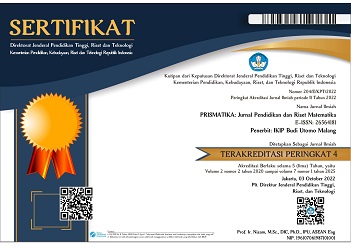PENGEMBANGAN MODUL MATEMATIKA YANG BERORIENTASI PADA MODEL PEMBELAJARAN HEURISTIK VEE
Abstract
Modules are learning resources that are presented in a systematic and planned manner to achieve learning objectives. The research has the aim of improving student's understanding and learning outcomes, by making teaching modules that are directed at the Heuristic Vee learning model. This research was developed using a research and development plomp model which was modified into several stages which included the initial investigation, design, realization/construction, and evaluation and revision tests. Data collection techniques used include test questions, questionnaires, and observations. The research subjects were students of Ambulu Islamic Junior High School class VII A. The quality of the modules developed was seen from the aspect of validity, from material experts it scored 85 very valid predicates, a score of 96 from media experts with very valid predicates, and lesson plans scored 89 very valid predicates. Another instrument that was validated in the form of an observation sheet on the implementation of learning the value of 93 predicates was very valid. In the validation of student activity observations, students scored 92 very valid predicates and teacher activity observation validation scored 92 very valid predicates. In the practical aspect, the results of the observational analysis of the implementation of learning with a score of 89 predicates are very practical. In the student response questionnaire, the score of 88 predicates was very practical, while the teacher's response questionnaire obtained a score of 90 with the very practical predicate. From the aspect of effectiveness, the module development was declared effective based on the results of the pre and post-test analysis which obtained an average increase of 21 so that it had a very effective level. From the results of the analysis of student activities, 91 predicates were very effective. Based on the results of the analysis, it can be concluded that this research resulted in the development of the module which was stated to meet the practical, valid, and effective aspects.
References
Arikunto, Suharsismi., 2012. Dasar-Dasar Evaluasi Pendidikan. Jakarta. Bumi Aksara.
Daryanto. 2016. Media Pembelajaran. Yogyakarta.Gava Media.
Harso, I.W. Suastra, & A.A.I.A R. Sudiatmika 2013. Pengaruh Model Pembelajaran Heuristik Vee Terhadap Pemahaman Konsep Fisika danSikap Ilmiah Siswa kelas X SMA Negri 2 Langke Rembong. Buleleng. E-journal Program Pascasarjana Universitas Ganesha Vol 4.
Lasmiyati, dkk . 2014 . Pengembangan Modul Pembelajaran Untuk Meningkatkan Pemahaman Konsep dan Minat SMP . Kaloka Jurnal Pendidikan Matematika. 9 (2) :161-174.
Mayasari, Niky.. 2020. Analisis Kesulitan Siswa dalam Mengerjakan Soal Matematika Materi Perbandingan Kelas VII SMP Luhur Baladika. Bengkulu. Jurnal Equation Teori dan Pendidikan Matematika 3 (1) :22 – 45.
Plomp, T. 2012. Generic Model for Education Desain (Problem, Analysis, Design, Implementation, Evaluation). Enschede. University of Twente.
Purwanto, M.N,. 2017. Ilmu Penddikan Teoritik dan Praktik. Bandung : Remaja Rosdakarya.
Rahmawati, R. 2018. Pengaruh Strategi Pembelajaran Heuristik Vee terhadap Pemahaman Konsep Matematika Peserta didik. Skripsi tidak di terbitkan . Lampung :. Universitas Negri Raden Intan Lampung.
Rochmat. 2012. Desain Model Pengembangan Perangkat Pembelajaran Matematika.
Zaqiyah, K., Lutfiyah., Dwi Noviani Sulisawati. 2020. Pengembangan Modul Berbasis Realistic Mathematics Education untuk Pembelajaran Bangun Ruang Sisi Lengkung. LAPLACE: Jurnal Pendidikan Matematika, Vol. 3, No. 2 (2020): 151 - 162.







.png)




